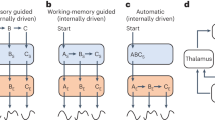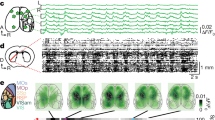Summary
Rats emit grooming actions in sequences that follow characteristic patterns of serial order. One of these patterns, a syntactic chain, has a particularly stereotyped order that recurs spontaneously during grooming thousands of times more often than could occur by chance. Previous studies have shown that performance of this sequence is impaired by excitotoxin lesions of the corpus striatum. In this study we examined whether the striatum is unique in its importance to this behavioral sequence or whether control of the sequence instead depends equally upon the cortex and cerebellum. In two experiments, a fine-grained behavioral analysis compared the effects of striatal ablation to the effects of motor cortex ablation, ablation of the entire neocortex, or ablation of the cerebellum. Cortical and cerebellar aspiration produced mere temporary deficits in grooming sequences, which appeared to reflect a general factor that was nonsequential in nature. Only striatal damage produced a permanent sequential deficit in the coordination of this syntactic grooming chain. We conclude that the striatum has a unique role in the control of behavioral serial order. This striatal role may be related to a number of sequential disorders observed in human diseases involving the striatum.
Similar content being viewed by others
References
Aldridge JW, Berridge KC, Herman M (1990) Single unit activity in the rat caudate-putamen during stereotypical grooming sequences. Neurosci Abstr 16: 233
Aldridge JW, Gilman J, Dauth G (1990) Spontaneous neuronal unit activity in the primate basal ganglia and the effects of precentral cerebral cortical ablations. Brain Res 516: 46–56
Barone P, Joseph JP (1989) Prefrontal cortex and spatial sequencing in macaque monkey. Exp Brain Res 78: 447–464
Berntson GG, Jang JF, Ronca AE (1988) Brainstem systems and grooming behaviors. Ann New York Acad Sci 525: 350–362
Berridge KC (1989a) Progressive degradation of serial grooming chains by descending decerebration. Behav Brain Res 33: 241–253
Berridge KC (1989b) Substantia nigra 6-OHDA lesions mimic striatopallidal disruption of syntactic grooming chains: a neural systems analysis of sequence control. Psychobiology 17: 377–385
Berridge KC (1990) Comparative fine structure of action: rules of form and sequence in the grooming patterns of six rodent species. Behavior 113: 1–2
Berridge KC, Fentress JC (1986) Contextual control of trigeminal sensorimotor function. J Neurosci 9: 325–330
Berridge KC, Fentress JC (1987a) Deafferentation does not disrupt natural rules of action syntax. Behav Brain Res 23: 69–76
Berridge KC, Fentress JC (1987b) Disruption of natural grooming chains after striatopallidal lesions. Psychobiology 15: 336–342
Brunner RS, Kornhuber HH, Seemüller E, Suger G, Wallesch C-W (1982) Basal ganglia participation in language pathology. Brain Language 16: 281–299
Buchtel HA (1970) Visual-learning deficits following cerebellar damage in rats. J Comp Physiol Psychol 72: 296–305
Cools, AR (1985) Brain and behavior: hierarchy of feedback systems and control of input. In: Bateson PPG, Klopfer PH (eds). Perspectives in ethology. Plenum, New York, 109–168
Cromwell HC, Berridge KC (1990) Anterior lesions of the corpus striatum produce a disruption of stereotyped grooming sequences in the rat. Neurosci Abstr 16: 233
Cummings JL, Frankel M (1985) Gilles de la Tourette syndrome and the neurological basis of obsessions and compulsions. Biol Psychiatr 20: 1117–1126
Dichgans J (1984) Clinical symptoms of cerebellar dysfunction and their topodiagnostic significance. Human Neurobiol 2: 269–279
Divac I, Oberg GE, Rosenkilde CE (1987) Patterned neural activity: implications for neurology and neuropharmacology. In: Schneider JS, Lidsky TI (eds). Basal ganglia and behavior: sensory aspects of motor fractioning. Huber, Toronto, pp 61–70
Donoghue JP, Wise SP (1982) The motor cortex of the rat: cytoarchitecture and microstimulation mapping. J Comp Neurol 212: 76–88
Evarts EV, Wise SP (1984) Basal ganglia outputs and motor control. Ciba Found Sympos 107: 83–102
Fentress JC (1983) Ethological models of hierarchy and patterning of species-specific behavior. In: Satinoff E, Teitelbaum P (eds). Handbook of behavioral neurobiology. Plenum, New York, pp 185–234
Fentress JC, Stilwell F (1973) Grammar of a movement sequence in inbred mice. Nature (Lond) 244: 52–53
Ferron J, Lefebvre L (1982) Comparative organization of grooming sequences in adult and young sciurid rodents. Behaviour 81: 110–127
Gallistel CR (1980) The organization of action: a new synthesis. Erlbaum, Hillsdale NJ
Golani I, Wolgin DL, Teitelbaum P (1982) A proposed natural geometry of recovery from akinesia in the lateral hypothalamic rat, Brain Res 164: 237–67
Goldman-Rakic PS (1987) Circuity of primate prefrontal cortex and regulation of behavior by representational memory. Hand Physiol 5: 373–417
Iversen SD, Mishkin M (1979) Behavior after neostriatal lesions in animals. In: Divac I, Oberg RGE (eds) The neostriatum. Pergamon, New York, 183–195
Iversen SD, Mishkin M (1970) Perseverative interference in monkeys following selective lesions of the inferior prefrontal conexity. Exp Brain Res 11: 376–386
Kelley AE, Domesick VB, Nauta WJH (1982) The amygdalostriatal projection in the rat. An anatomical study by anterograde and retrograde tracing methods. Neuroscience 615–630
Kirk WT, Berntson GG, Hothersall D (1982) Effects of paleocerebellar lesions on DRL performance in the albino rat. J Comp Physiol Psychol 96: 348–360
Kolb B (1984) Functions of the frontal cortex of the rat: A comparative review. Brain Res 8: 65–98
Kolb B & Milner B (1981) Performance of complex arm and facial movements after focal lesions. Neuropsychology 19: 505–514
Kolb B, Whishaw IQ & Schallert T (1972) Behavior sequencing, sensory neglect, and bodyweight set point following orbital frontal lesions in rats. Physiol Behav 19: 93–102
Kurata K, Wise SP (1988) Premotor and supplementary motor cortex in Rhesus monkeys: neuronal activity during externally — and internally — instructed motor tasks. Exp Brain Res 72: 237–284
Lashley KS (1951) The problem of serial order in behavior. In: Jeffress LA (eds) Cerebral mechanisms in behavior. Wiley, New York, pp 112–136
Lashley KS, McCarthy DA (1926) The survival of the maze habit after cerebellar lesions. J Comp Psychol 6: 423–433
Levitt DR, Teitelbaum P (1975) Somnolence, akinesia, and sensory activation of motivated behavior in the lateral hypothalamic syndrome. Proc Nat Acad Sci 72: 2819–2823
Luxenberg JS, Swedo SE, Flament MF, Friedland RP, Rapoport JL, Rapoport SI (1988) Neuroanatomical abnormalities in obsessive-compulsive disorder detected with quantitative x-ray computed tomography. Am J Psychiatr 145: 1089–1093
MacLean PD (1990) The Triune Brain in evolution: Role in Paleocerebral Functions. New York: Plenum
Manetto C, Lidsky TI (1987) Influences of the basal ganglia on the medullary reticular formation. Neurosci Let 75: 278–282
Marsden CD (1982) The mysterious motor function of the basal ganglia: The Robert Wartenberg lecture. Neurology 32: 514–539
Nauta WJH, Domesick VB (1984) Afferent and efferent relationships of the basal ganglia. In: Evered D, O'Connor M (eds) Functions of the basal ganglia: Ciba Foundation Symposium. Pitman, London, 107:3–23
Neafsey EJ (1990) The complete ratunculus: output organization of layer V of the cerebral cortex. In Kolb B, Tees RC (eds) The cerebral cortex of the rat. MIT, Cambridge, pp 197–212
Neafsey EJ, Bold EL, Haas G, Hurley-Gius KM, Quirk G, Sievert CF, Terreberry RR (1986) The organization of the rat motor cortex: a microstimulation mapping study. Brain Res Rev 11: 77–96
Passingham RE, Chen YC, Thaler D (1989) Supplementary motor cortex and self-initiated movement. In: Ito M (eds) Neural programming. Karger, Basel, pp 13–24
Paxinos G, Watson G (1989) The rat brain in stereo toxic coordinates. Academic New York
Pellegrino LJ, Altman J (1979) Effects of differential interference with postnatal cerebellar neurogenesis on motor performance, activity level, and maze learning of rats: a developmental study. J Comp Physiol Psychol 93: 1–33
Pisa M, Cyr J (1990) Regionally selective roles of the rat's striatum in modality-specific discrimination learning and forelimb reaching. Behav Brain Res 37: 281–292
Petrides M, Milner B (1982) Deficits on subject-ordered tasks after frontal- and temporal-lobe lesions in man. Neuropsychology 20: 249–262
Rapoport JL (1989) The boy who couldn't stop washing: the experience and treatment of obsessive-compulsive disorder. Penguin Books, New York
Rapoport JL, Wise SP (1988) Obsessive-compulsive disorder: evidence for basal ganglia dysfunction. Psychopharm Bull 24: 380–384
Richmond G, Sachs BD (1980) Grooming in Norway rats: the development and adult expression of a complex motor pattern. Behavior 75: 82–96
Schneider JS, Kovelowski CJ 2d. (1990) Chronic exposure to low doses of MPTP. In: Cognitive deficits in motor asymptomatic monkeys. Brain Res 519, 122–128
Shelton PA, Knopman DS (1991) Ideomotor apraxia in Huntington's disease. Arch Neurol 48: 35–41
Thompson R (1974) Localization of the “maze memory system” in the white rat. Physiol Psychol 2: 1–17
Vanderwolf CH, Kolb B, Cooley RK (1978) Behavior of the rat after removal at the neocortex and hippocampal dormation. J Comp Physiol 92: 156–175
Van den Bercken JH, Cools AR (1982) Evidence for a role of the caudate nucleus in the sequential organization of behavior. Behav Brain Res 4: 319–327
West O, Carelli RM, Pomerantz M, Cohen SM, Gardner JP, Chapin JK, Woodward DJ (199) A region in the dorsolateral striatum of the rat exhibiting single-unit correlations with specific locomotor limb movements. J Neurophysiol 64:1233–1246
Whishaw IQ (1990) The decorticate rat. In: Kolb B, Tees RC (eds) The cerebral cortex of the rat. MIT, Cambridge, pp 239–268
Whishaw IQ, Kolb M, Sutherland RJ (1983) The analysis of behavior in the laboratory rat. In: Robinson TE (eds) Behavioral approaches to brain research. Oxford University Press, New York, pp 141–211
Whishaw IQ, O'Connor WT, Dunnett SB (1985) Disruption of central cholinergic systems in the rat by basal forebrain lesions or atropine: effects on feeding, sensorimotor behaviour, locomotor activity, and spatial navigation. Behav Brain Res 17: 103–115
Whishaw IQ, Nonneman AJ, Kolb B (1981) Environmental constraints on motor abilities used in grooming, swimming, and eating by decorlicate rats. J Comp Physiol Psychol 95: 792–804
Zilles K (1990) Anatomy of the neocortex: cytoarchitecture and my eloarchitecture. In: Kolb B, Tees RC (eds) The cerebral cortex of the rat. MIT, Cambridge, pp 77–112
Author information
Authors and Affiliations
Rights and permissions
About this article
Cite this article
Berridge, K.C., Whishaw, I.Q. Cortex, striatum and cerebellum: control of serial order in a grooming sequence. Exp Brain Res 90, 275–290 (1992). https://doi.org/10.1007/BF00227239
Received:
Accepted:
Issue Date:
DOI: https://doi.org/10.1007/BF00227239




